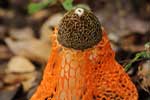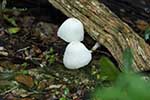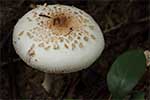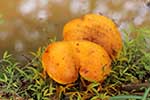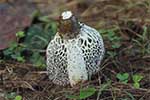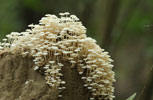
Wild mushrooms ‹‹ Go Back
Fungi
Fungi have a fascinating life cycle which is very different from that of plants. Unlike plants they are not made of cellulose but of Chitin which is found on the hard exterior of insects such as beetles. Mushrooms also do not hold chlorophyll like plants and thus cannot synthesize their own food with the help of the sun’s energy like plants. They must depend on external sources for their food. Fungi also do not propagate via seeds but instead produce tiny spores that resembles an airborne powder that is carried long distances with the wind. When a microscopic spore drops on a moist location, it germinates and produces tiny, microscopic threads. These threads grow into a huge mass referred to as the mycelium, which, in fact, is the true body of the fungi. What is most interesting is that the mushrooms we observe once a year are only the fruits of the fungi. The mycelium continues its life throughout the year underground, inside decaying woods or leaves, inside hay stacks, or even on live trees. Despite the experts on fungi estimating that there may be about 34,000 species found in the country, the knowledge on the subject remains extremely low due to the un-availability of any authoritative field guides and comprehensive studies. A little over 2,000 species of fungi are currently known in the country.
This page was made possible due to the support given by Prof. Samantha C. Karunaratna in Qujing Normal University, P.R. China, who is an expert and a leading authority on fungi who very kindly agreed to identify the mushrooms found in the park.
References
Karunarathna, S.C., Udayanga, D., Maharachchikumbura, S.N., Pilkington, M., Manamgoda, D.S., Wijayawardene, D.N.N., Ariyawansa, H.A., Bandara, A.R., Chukeatirote, E., McKenzie, E.H.C. and Hyde, K.D. (2012). Current status of knowledge of Sri Lankan mycota. Current Research in Environmental & Applied Mycology 2(1):18-29.
Wijayawardene, N.N., Rajakaruna, S., Dai, D.Q., Jayasekara, S., Warnakula, L., Ariyawansa, K.G.S.U., Fernando, E.Y., Jayasekera, P., Karunarathna, S.C., Singhalage, D. and Ukuwela, K. (2021). Necessity of a national fungarium and a culture collection for fungi in Sri Lanka. Chiang Mai Journal of Science 49(2): 248-271.
Wijayawardene, N.N., Dai, D.Q., Premarathne, B.M., Wimalasena, M.K., JAYALAL, R.U., Wickramanayake, K.D., Dangalla, H., Jayathunga, W.H., Brahmanage, R.S., Karunarathna, S.C. and Weerakoon, G. (2023). Checklist, typification details, and nomenclature status of ascomycetous fungi originally described in Sri Lanka. Phytotaxa 611(1): 1-105.

